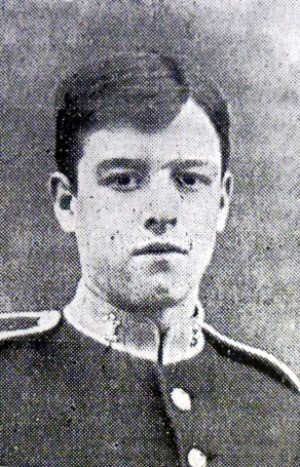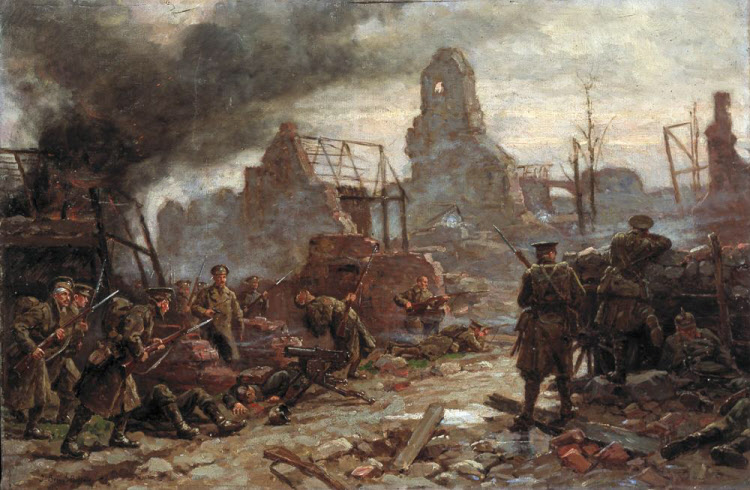
Willie Chappell was born on the 26th July 1894 in Ossett to Alfred Chappell (born Hensall, Goole in 1857) and Mary (nee Dixon, born Barnsley 1860). The couple were married in Ossett in 1876. At the time of Willie’s birth in 1894, his father Alfred was working as a farm labourer at Lodge Hill Farm, Flushdyke, Ossett, where the family also lived. Earlier, in 1881, the Chappells lived in Dewsbury Road, Ossett when Alfred was working as a teamer. They were four children by 1891 and in 1901, the Chappell family, now with eight children, including six year-old Willie Chappell, are all living at Bottomfield Yard, Wakefield Road, Ossett. The father, Alfred Chappell is still employed as a farm labourer. By 1911, the Chappell family have moved again to a three-roomed house at 4, Stithy Street, Ossett, with five children and a grandchild still at home, including Willie, who was then working as a mule piecer for a blanket manufacturer.
Willie’s mother, Mary Chappell died in 1913 aged 54 and for some time before the start of WW1, Willie Chappell left home and went to live with his uncle, Fred Chappell, 40 Clark’s Buildings, Dewsbury Road, Ossett. Fred Chappell was a railway signalman and must have moved to Ossett sometime after 1911 with his wife and family. Oddly, Fred Chappell was his nephew’s named next-of-kin rather than Willie’s father Alfred Chappell, who lived at Ossett until his death in 1927 aged 71. Willie worked as a miner at Shaw Cross Colliery, but had joined the reserve army as a volunteer before WW1 started and was with his regiment undergoing training when the war broke out. From August 1914 to January 1915, he continued with his training in the U.K. and made a few days’ visit to see his relatives in Ossett shortly before Christmas 1914.
Early in February 1915, his uncle Fred received a letter from him, stating that he had arrived in the fighting area (in France) and was all right. Willie Chappell had actually arrived in France on the 10th February 1915. A month or so later, another letter was received by his uncle in Ossett, addressed from a clearing hospital in France, intimating that his nephew had been admitted to that hospital, suffering from a wound in the back, caused by a shell.
Another month elapsed without further news of the young soldier, but soon after Easter 1915, his relatives were greatly concerned on seeing his name, with number and regiment, posted in a list of casualties of soldiers who had died from wounds. Communicating with the War Office, the uncle received an official response from that quarter, confirming the report of the soldier’s death, which it appeared had occurred within a couple of days of his admission to hospital.1
Private Willie Chappell as part of the 23rd Infantry Brigade was fatally wounded at the Battle of Neuve Chapelle, March 10th – 13th 1915. It was the Allies first big engagement since the terrible fight for the French coast towns in the preceding October and November of 1914. Throughout the winter our troops had been fast in the trenches, and as the spring of 1915 approached they looked forward longingly to the great advance, which they, as well as the people at home, believed would be made. Many heroic deeds were done on these three days; all regiments fought with valour, but a number of our men distinguished themselves above all others, and ten of these gained the Victoria Cross.2
In most areas, the first phase of the infantry attack went well, with the troops rapidly gaining the enemies front-line trenches, and the village itself within 45 minutes. However, there were failures both to the north (where the initial bombardment had not been effective) and to the south (where the attacking troops set off at a tangent to their planned objectives, and thus came up against sectors of the enemy trench which had not been bombarded and were well defended. However, as the day progressed, the attack was held up; partly by problems with communications (especially between units of different brigades and Divisions) and partly because of mistaken intelligence (for example it was thought that an orchard in the northern part of the battlefield was strongly defended whereas in fact it was not held by the enemy at all). The Germans, who had been taken by surprise, were able to bring up reinforcements and mount counter attacks over the next two days, and although reports of operations cover the 10th – 14th March, the Battle is officially considered as just the three days of 10th, 11th and 12th. The casualty figures for the British were around 3,500 killed and 8,500 wounded. German casualty figures are more difficult to come by, but must have also run into thousands.3

Above: The taking of Neuve-Chapelle (Pas-de-Calais) by the British, 10 March 1915. Oil on canvas by Jean-Jacques Berne-Bellecour (1874-1939). Painted in 1916.
Willie Chappell was only 20 years of age when he died from his wounds on the 10th March 1915. He is buried in Merville Communal Cemetery4, grave reference I.D.3. Merville is 15 kilometres north of Bethune and about 20 kilometres south-west of Armentieres in northern France and was the scene of fighting between the Germans and French and British cavalry early in October 1914 but from the 9th of that month to the 11th April 1918, it remained in Allied hands. In October 1914, and in the autumn of 1915, the town was the headquarters of the Indian Corps. It was a railhead until May 1915, and a billeting and hospital centre from 1915-1918.
For his service in the British Army, Willie Chappell was awarded the British and Victory medals and also the 1915 Star for serving in a theatre of war pre 31st December 1915. The medals were sent Willie Chappell’s uncle Fred at 28, Bridle Lane, Ossett on the 5th May 1921.
References:
1. “Ossett Observer”, 10th April 1915
2. The Baldwin Project
3. World War One Battlefields